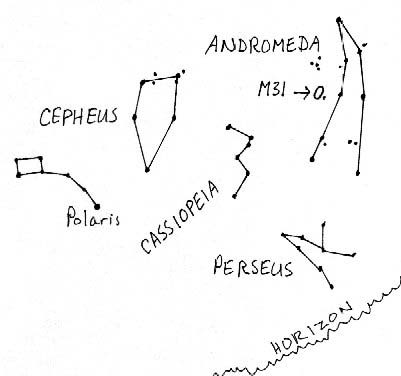Andromeda was the daughter of Cepheus and Cassiopeia, the king and queen of Ethiopia. Cassiopeia bragged that her daughter was more beautiful than the Nereids, the mermaid daughters of Nereus and special favorites of Poseidon. Such impudence could not be tolerated, and Cassiopeia had to be punished - so the angry god sent a sea monster to ravage the kingdom, and Andromeda in particular. (Why not ravage Cassiopeia? Who knows?) An oracle told Papa Cepheus that turning over his daughter to the monster was the only way to save the kingdom, so he and his wife chained their daughter to a rock by the sea.
Luckily for Andromeda, Perseus, son of Jupiter/Zeus, passed by Ethiopia on his way home from having liberated the Gorgon Medusa's head from her body. He was smitten by the lovely, damp, and helpless virgin princess, and told her parents he would free her in exchange for her hand in marriage. They agreed, and when the monster arrived, Perseus battled it to the death.
Trouble lay ahead of the young god, though. At the wedding feast, Phineus, Andromeda's former suitor, showed up purporting to have the rightful claim to her. He threw his javelin, badly, at Perseus, then hid behind a table as a battle broke out.
The pals of Perseus were vastly outnumbered by the home team, but then Perseus remembered his secret weapon. He called out, "If you are my friend, turn away from me now," and pulled out Medusa's head. One by one, the local toughs were turned to stone. Phineus emerged to find all of his buddies frozen. He fell at Perseus's feet, his head turned to the side, and begged to have his life spared.
Perseus said, "No weapon shall ever harm you. In fact, I will keep you in my house as a memorial of this day." The he swung the Gorgon's head around to the side, causing Phineus, too, to turn to stone.
And they lived happily ever after, as long as Andromeda kept attending her weekly counseling sessions with Dr. Ophiuchus.
So on to the stars. Cassiopeia, you'll remember, is the W-shaped constellation to the left of Polaris, and Perseus is still hugging the horizon below the left side of Cassiopeia. The dimmer northern branch of the Milky Way runs through both of the constellations.
 Cepheus (SEE-fee-us) is between the open side of Cassiopeia and Cygnus, and also in the Milky Way. At this time of year, Cepheus looks like an upside-down house. Right side up, he resembles, as the myth suggests, a blockhead in a crown. The a line between the farthest right star in Cassiopeia's W and the peak of Cepheus's crown/house points, more or less, towards Polaris.
Cepheus (SEE-fee-us) is between the open side of Cassiopeia and Cygnus, and also in the Milky Way. At this time of year, Cepheus looks like an upside-down house. Right side up, he resembles, as the myth suggests, a blockhead in a crown. The a line between the farthest right star in Cassiopeia's W and the peak of Cepheus's crown/house points, more or less, towards Polaris.
Andromeda is on the pointy side of the W. The constellation is shaped like a long, crooked V. Use the right V of Cassiopeia to point out the most notable feature, the Andromeda Galaxy (M31). A large fuzzy patch is visible to the naked eye from a dark location. With binoculars, some of the galaxy's central brightness is visible. With a small telescope, you will see that there two smaller galaxies, M32 and M110, near M31.
The Andromeda Galaxy is a spiral galaxy similar to our own, but almost one and a half times larger. At 2.3 million light years away from Earth, it is one of the most distant objects visible to the unaided eye.

The Piker Press moderates all comments.
Click here for the commenting policy.